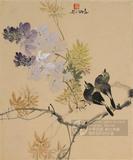明王紱古木竹石 軸
推薦分享
資源連結
連結到原始資料 (您即將開啟新視窗離開本站)後設資料
- 資料識別:
- 故畫000389N000000000
- 資料類型:
- 類型:繪畫
- 型式:靜態圖像
- 著作者:
- 王紱
- 主題與關鍵字:
- 奇石 竹 寒林.枯樹
- 出版者:
- 數位化執行單位:國立故宮博物院
- 格式:
- 本幅 127.4x44.3公分、全幅 68.5公分
- 關聯:
- 石渠寶笈初編(御書房),下冊,頁1141&*故宮書畫錄(卷五),第三冊,頁285&*故宮書畫圖錄,第六冊,頁39-40&*王紱(西元一三六二至一四一六年),無錫人,字孟端,後以字行,號友石,又號九龍山人,青城山人。永樂間,以墨竹名天下,兼善山水。 古木竹石,為山水家酬應之作,明以後常有此題。本幅用筆極為老辣,古木一枝,筆法已開沈周法門。竹秀而渾,石樸而妍,雖著筆無多,而自挺然傑出。 &*Wang Fu was a native of Wu-hsi, Kiangsu. His tzu (style name) was Meng-tuan; his hao (sobriquets) were Yu-shih, Chiu-lung-shan-jen, and Ch'ing-ch'eng-shan-jen. During the Yung -lo period (1403-1424) Wang Fu was famed for his paintings of ink bamboo. He also excelled in painting landscapes. A painting combining an old tree with a rock or two and bamboos was a favorite gift presented by a landscape painter on social occasions. After the Ming Dynasty (1368-1644), this practice became quite prevalent. Wang Fu's brushwork in this painting is highly skilled. The brush technique used to depict this ancient tree was inspiration for Shen Chou's (1427-1509) unique style. The bamboos are elegantly executed and the weathered rock is fantastically shaped. Wang Fu painted with economy of brushwork, yet created a tranquility beyond this clamorous mundane world.
- 管理權:
- 國立故宮博物院
授權聯絡窗口
- 國立故宮博物院圖像授權、出版授權、影音資料授權-申請流程說明
http://www.npm.gov.tw/zh-TW/Article.aspx?sNo=03003061






